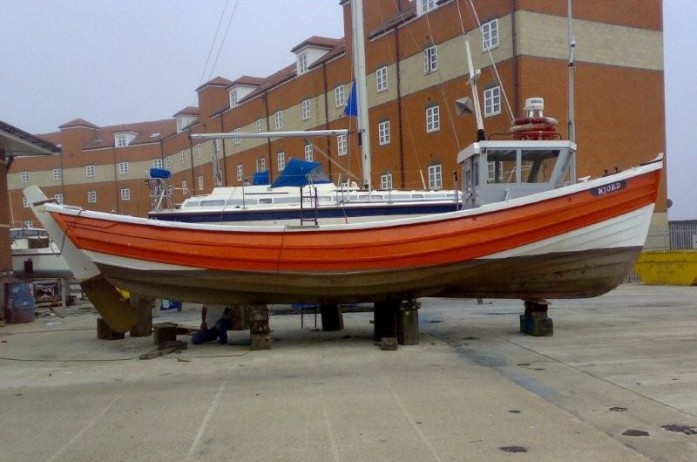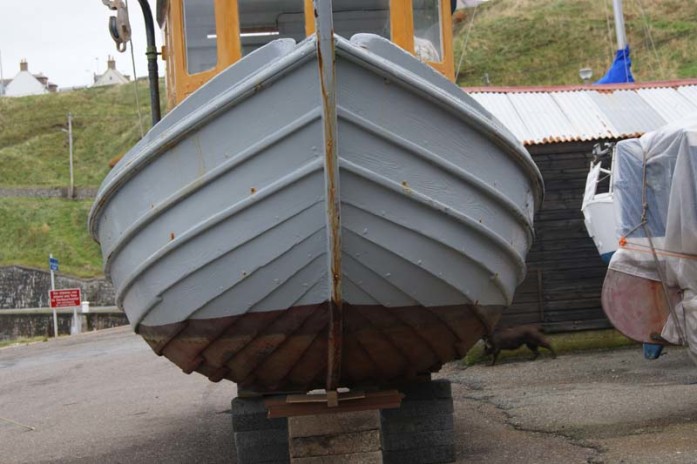The coble is a type of open fishing boat used mostly on the North East coast of England. The southern examples occur up around Hull; the type extends to Burnmouth, across the Scottish border.
Coble has a distinctive shape — flat-bottomed and high-bowed. It is built like taht to cope with the particular conditions in this area. Flat bottoms allowed launching from and landing upon shallow, sandy beaches, which is an advantage in this part of the coast where the wide bays and inlets provided little shelter from stormy weather. Fishermen required high bows to sail in the dangerous North Sea’s waters and in particular to launch into the surf and to land on the beaches. The design contains relics of Norse influence, though in the main it shows Dutch origin.

Traditional English Coble (North Eastern Coast)
[source]
A Scottish version of the coble, much shallower and beamier than the English type, used to serve for salmon-fishing off beaches near Arbroath and Montrose in Angus. These cobles have a less refined construction than their southern counterparts. Ghillies employ a smaller, better-built version for fly fishing on Scottish rivers.
The Scottish coble has vanished from the shores, to be found rotting away near former fishing stations, or converted for other uses. No new wooden cobles have been built since the 1970s, although fiber glass examples continued to be constructed for a number of years. The disappearance of the coble coincided with the downfall of the salmon fishing industry in the early 1990s. For a variety of reasons, one after another, long established companies regretfully decided to give up their fishing rights, and with them their salmon cobles. Fortunately, not all of the families in the area did the same. There still are two valuable cobles to be found, because they were refurbished.

Scottish Coble
[source]
Local boat-builders constructed the clinker-built cobles locally as required, without the use of plans. The craftsmanship on many boats gave them a long working life. They had a reputation as dangerous to sail for an inexperienced crew, but in the hands of experts could move both safely and speedily. I believe that these are sailors’ tales to tell in the windy evenings in a pub, to accompany a nice single malt whiskey and a pipe.
Today, surviving cobles generally use diesel engines, removing the need for the distinctively shaped lug sail. In a further concession to comfort, a tarpaulin shelter often covers the bow. Design varies from place to place and from builder to builder. Builders would also vary their basic design a little to suit the fisherman who might specialize one part of the fishing trade, or have strong views about his boat! The modern cobles often have a small wheelhouse forward, perhaps a half deck to shelter the engine, and gantries to support line haulers; both possible because there is now no sailing gear.
The Northumberland coastal village of Newbiggin-by-the-Sea has a pub called “The Coble”, named as a tribute to these boats. Nothing more appropriate to do, if you ask me.
Most of this article is oriented after the one in Wikipedia. Other sources are from the Scottish Traditional Boat Festival website.
I have paused a little my definitions’ series here, but I’m going to continue their publishing in a less scarce fashion.
If you like what you read, please subscribe to this blog by completing the form. If you want to help more, start by following us on Twitter, and like our page on Facebook. You don’t know what good things may happen. To lighten your day, check our pins on Pinterest, we can be friends there too. Oh, and if you need a really good looking blog attached to your site, or just for fun, to express your feelings more competitively, read this Own Your Website offer! Thank you very much.

Hi I have a small coble and want to find out more about setting her up.